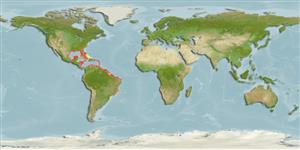>
Tetraodontiformes (Puffers and filefishes) >
Diodontidae (Porcupinefishes (burrfishes))
Etymology: Chilomycterus: Greek, cheilos = lip + Greek, mykter, -eros = nose (Ref. 45335).
More on authors: Jordan & Rutter.
Environment: milieu / climate zone / depth range / distribution range
Ecologia
marino associati a barriera corallina; distribuzione batimetrica 1 - 44 m (Ref. 9710). Tropical
Western Atlantic: southeastern Florida, USA and the Bahamas to northeastern Brazil (Ref. 13608).
Size / Peso / Age
Maturity: Lm ? range ? - ? cm
Max length : 30.0 cm TL maschio/sesso non determinato; (Ref. 26938)
Spine dorsali (totale): 0; Raggi dorsali molli (totale): 13; Spine anali 0; Raggi anali molli: 11 - 12. Body with five or more black blotches and a fine network of lines which cuts off pale, cell-like areas (Ref. 5521). Spines short, especially those ventrally on body, and rigidly erect; 12 spines in an approximately row from front of head to dorsal fin; a large black spot above pectoral fin and a smaller one beneath and posterior to fin (Ref. 13442).
Inhabits coral reefs with adjacent seagrass and rubble areas (Ref. 9710). Between 1995 and 2000, at least 10 specimens have been traded as aquarium fish at Ceará, Brazil (Ref. 49392).
Life cycle and mating behavior
Maturità | Riproduzione | Deposizione | Uova | Fecundity | Larve
Uyeno, T., K. Matsuura and E. Fujii (eds.), 1983. Fishes trawled off Suriname and French Guiana. Japan Marine Fishery Resource Research Center, Tokyo, Japan. 519 p. (Ref. 13608)
IUCN Red List Status (Ref. 130435)
Threat to humans
Harmless
Human uses
Pesca: di nessun interesse
Informazioni ulteriori
Nomi ComuniSinonimiMetabolismoPredatoriEcotossicologiaRiproduzioneMaturitàDeposizioneSpawning aggregationFecundityUovaEgg development
BibliografiaAcquacolturaProfilo di acquacolturaVarietàGeneticaElectrophoresesEreditarietàMalattieElaborazioneNutrientsMass conversion
Strumenti
Special reports
Download XML
Fonti Internet
Estimates based on models
Preferred temperature (Ref.
123201): 24.3 - 28, mean 27 °C (based on 306 cells).
Phylogenetic diversity index (Ref.
82804): PD
50 = 0.5313 [Uniqueness, from 0.5 = low to 2.0 = high].
Bayesian length-weight: a=0.04786 (0.01967 - 0.11644), b=2.82 (2.61 - 3.03), in cm total length, based on LWR estimates for this (Sub)family-body shape (Ref.
93245).
Trophic level (Ref.
69278): 3.6 ±0.5 se; based on size and trophs of closest relatives
Resilienza (Ref.
120179): Alto, tempo minimo di raddoppiamento della popolazione meno di 15 mesi (Preliminary K or Fecundity.).
Fishing Vulnerability (Ref.
59153): Low vulnerability (20 of 100).
Nutrients (Ref.
124155): Calcium = 45.3 [19.3, 116.5] mg/100g; Iron = 0.617 [0.310, 1.425] mg/100g; Protein = 18.4 [16.2, 20.6] %; Omega3 = 0.117 [0.061, 0.222] g/100g; Selenium = 34.7 [17.6, 72.4] μg/100g; VitaminA = 56.8 [16.7, 198.9] μg/100g; Zinc = 1.06 [0.71, 1.58] mg/100g (wet weight);
